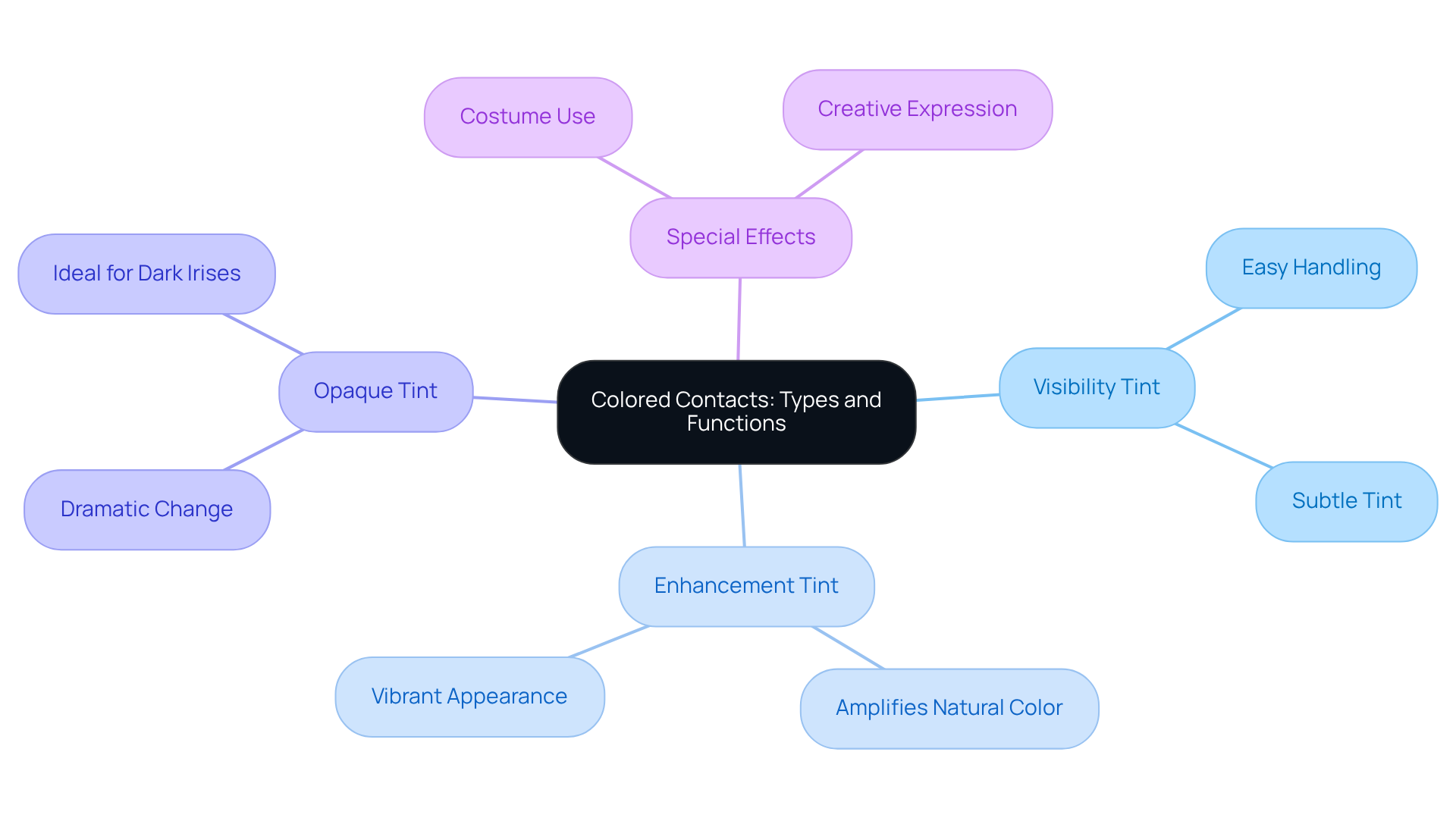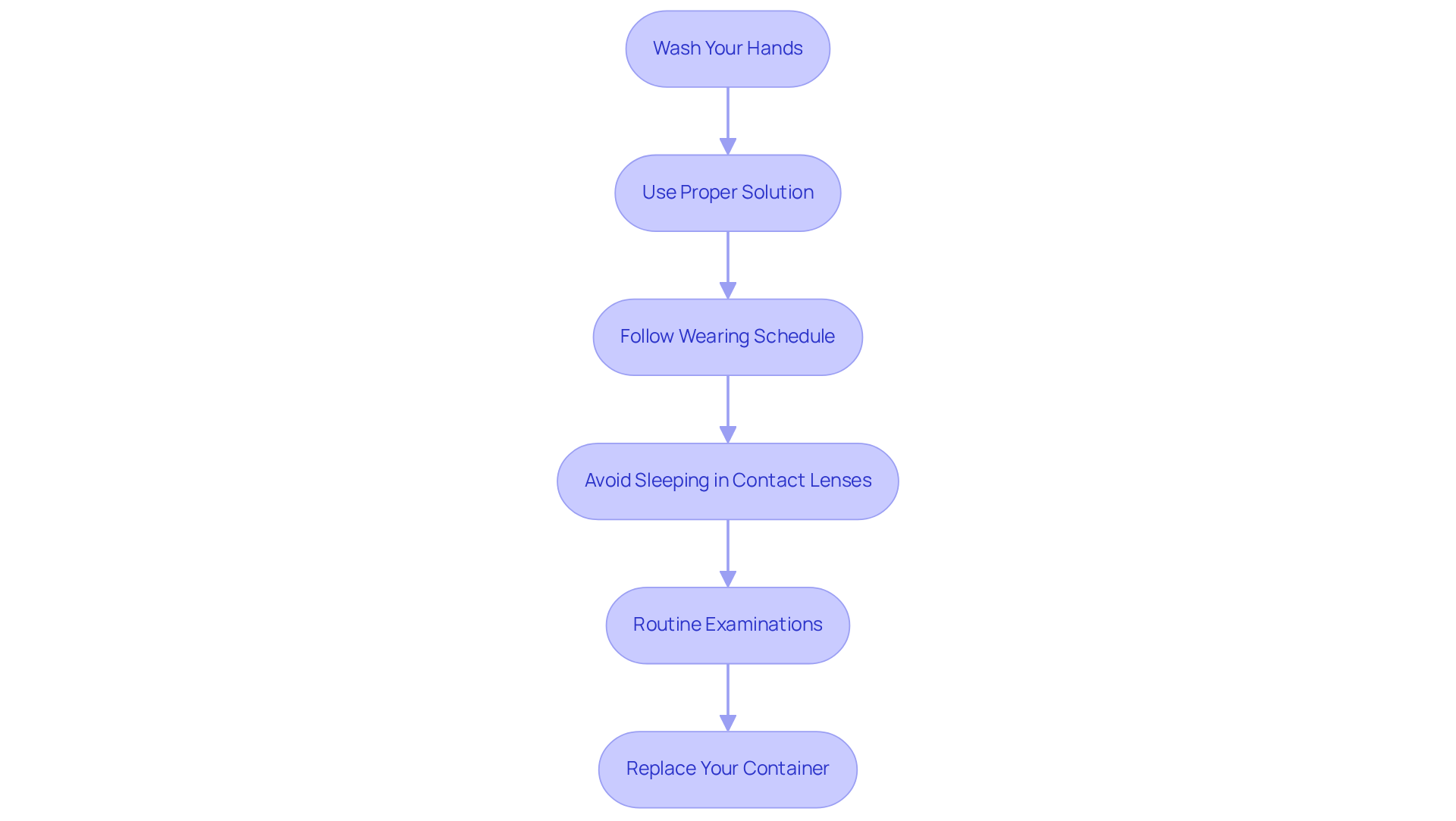Posted by: Northwest Eye in General on October 11, 2025
Overview
Choosing and caring for colored contacts with a prescription can feel overwhelming, but we’re here to help you through this process. It’s essential to understand the different types of lenses available and to ensure you obtain a proper prescription from an eye care specialist.
There are various lens types to consider, including:
- visibility
- enhancement
- opaque
- special effects tints
Each type serves a unique purpose, and knowing the differences can help you make an informed choice. Remember, having a valid prescription is crucial for your eye health and comfort.
Proper care practices are equally important. We understand that maintaining your eye health is a priority, and following the right care routines can make all the difference. By taking these steps, you can enjoy your colored contacts safely and comfortably.
Your well-being matters to us, and we encourage you to reach out to your eye care specialist with any questions or concerns. You are not alone in this journey, and together, we can ensure your experience is positive and fulfilling.
Introduction
Choosing the perfect pair of colored contacts can feel overwhelming, especially with so many options available today. We understand that you may want to enhance your natural beauty or make a bold fashion statement. Colored contacts serve a variety of aesthetic and functional purposes, but it’s common to feel uncertain about prescription requirements and proper care practices. How can you ensure that you select the right lenses while prioritizing your eye health?
This guide delves into the types of colored contacts, the importance of obtaining a valid prescription, and best practices for their use and maintenance. We are here to help you navigate these choices, empowering you to make informed decisions that support your vision and style.
Understand Colored Contacts: Types and Functions
There are several distinct categories of colored contacts with prescription, each tailored for specific aesthetic and functional purposes. We understand that choosing the right lenses can feel overwhelming, but knowing your options can help ease that process. The primary types include:
- Visibility Tint: These lenses feature a subtle tint that aids users in handling them, ensuring they can see the lenses easily without altering the natural eye color significantly. It’s common to feel unsure about handling lenses, but visibility tints can provide that extra assurance.
- Enhancement Tint: Semi-transparent in nature, enhancement tints amplify the natural color of the iris, resulting in a more vibrant appearance while maintaining the original hue. Many people find joy in enhancing their natural beauty, and these tints can help you achieve that.
- Opaque Tint: Designed to completely transform iris color, opaque tints are ideal for individuals with darker irises seeking a bold change. They provide substantial coverage, making them popular among those looking for dramatic effects. In fact, opaque tints hold a significant share of the colored contact market due to their popularity among fashion-conscious individuals and cosplayers. If you’re looking for a fun way to express yourself, opaque tints might just be what you need.
- Special Effects: Often utilized for costumes or theatrical performances, special effects optics can create striking appearances, such as cat eyes or zombie looks, catering to creative expression. We recognize that many enjoy experimenting with their looks, and special effects lenses can be a fantastic avenue for that.
Grasping these categories is vital for choosing the suitable perspective based on your preferred aesthetic and functional requirements, particularly when selecting colored contacts with prescription for daily use or special events. Current trends suggest an increasing consumer fascination with tinted eyewear, especially among younger groups swayed by social media and style. The worldwide colored contact products market is expected to hit $6,645.9 million by 2030, indicating this rising demand.
Eye care specialists emphasize the importance of selecting eyewear that not only improves appearance but also guarantees comfort and safety. They suggest appropriate fitting and maintenance to prevent issues, particularly with opaque and special effects optical devices. Furthermore, the trend of online buying, which represented 19% of lens acquisitions, suggests a change in consumer habits that is significant for those contemplating tinted lenses. Real-world examples of visibility tints being used for everyday wear and opaque tints for special occasions can further illustrate their practical applications. We are here to help you through this process, ensuring you find the right lenses for your needs.

Obtain a Prescription: Legal and Health Considerations
Before acquiring colored contacts with prescription, it’s essential to secure a valid prescription from an eye care specialist. We understand that this process may feel overwhelming, so here’s how to navigate it with care:
- Schedule an Eye Exam: Reach out to an optometrist or ophthalmologist to arrange a comprehensive eye exam. This assessment will evaluate your vision and overall eye health.
- Discuss your needs: During the exam, communicate your interest in colored contacts with prescription. The doctor will assess your eye shape, size, and any specific vision correction requirements for colored contacts with prescription.
- Get Fitted: The eye care professional will prepare you for the eyewear, ensuring they are both comfortable and safe for your eyes.
- Receive your prescription for colored contacts with prescription: Following the fitting, you will obtain a prescription specifying the type, curvature, and power.
It’s common to feel apprehensive about wearing tinted contacts without a prescription, as this can lead to severe eye health issues. Reports suggest that 1 in 4 patients have previously utilized cosmetic contacts acquired from unauthorized sources, leading to complications like infections and vision loss. For instance, a teenager named Julian experienced permanent blindness after using a non-prescription colored contact, highlighting the dangers linked to unregulated products. Furthermore, the American Academy of Ophthalmology stresses that decorative eyewear must be regarded as prescription eyewear to prevent hazardous infections.
Routine eye examinations are vital to guarantee appropriate fit and prescription precision. We are here to help you through this process, as incorrect usage can result in severe issues such as corneal abrasions and ulcers. Always prioritize safety by adhering to the required procedures to acquire a prescription for tinted eyewear.

Select the Right Colored Contacts: Key Factors to Consider
When selecting colored contacts with prescription, it’s important to consider several key factors that can enhance both your aesthetic appeal and comfort.
-
Eye Color: We understand that your natural eye color plays a significant role in how colored lenses will appear. For instance, enhancement tints work beautifully on lighter irises, subtly intensifying the existing hue. On the other hand, opaque tints are ideal for darker eyes, offering a more dramatic transformation.
-
Next, consider the interaction between your skin tone, hair color, and the selected tint color. Warm skin tones often pair well with brown or honey-colored eyewear, while cool skin tones may be enhanced by blue or gray options. This harmony not only improves your overall appearance but also ensures that your eyewear looks natural.
-
Situation: It’s common to feel uncertain about which colors to choose based on where you plan to wear your eyewear. For daily wear, subtle and natural colors are typically preferred, while vibrant hues can be exciting for special occasions or themed events.
-
Comfort and Material: Prioritize eyewear made from breathable materials that allow sufficient oxygen circulation to your eyes. We recommend discussing your options with your vision care expert, who can provide valuable suggestions on the best brands and types of colored contacts with prescription to suit your needs.
-
Market Insights: The global tinted eye products market is projected to reach USD 7.19 billion by 2030, reflecting a growing interest in these items. This trend highlights the importance of selecting the right lenses that not only enhance your look but also prioritize comfort and eye health.
By thoughtfully evaluating these elements, you can choose tinted lenses that not only elevate your appearance but also emphasize comfort and eye wellness. Remember, we are here to help you through this process.

Use and Care for Colored Contacts: Best Practices
To ensure the safe use and longevity of your colored contacts, we encourage you to adhere to these essential best practices:
- Wash Your Hands: Always cleanse your hands thoroughly with soap and water before touching your contacts. We understand that this simple step is crucial in preventing the transfer of dirt and bacteria, which can lead to serious infections.
- Use Proper Solution: Clean and store your lenses in a multi-purpose solution for vision aids. It’s important to avoid using water or saliva, as these can introduce harmful bacteria that compromise eye health. Research indicates that inadequate cleaning methods greatly elevate the likelihood of infections, with almost one-third of contact users encountering issues.
- Follow Wearing Schedule: Stick to the recommended wearing schedule provided by your eye care professional. We know that overextending wear time can lead to discomfort and increase the likelihood of eye health issues. For example, using contact devices during sleep can increase the likelihood of infections by as much as six times.
- Avoid Sleeping in Contact Lenses: Unless specifically designed for overnight use, always take out your contacts before sleeping. This practice is vital for reducing the risk of infections such as microbial keratitis, which can lead to severe vision complications.
- Routine Examinations: Arrange frequent appointments with your eye care specialist to assess your eye health and confirm your eyewear continues to meet your requirements. Routine examinations can assist in identifying possible problems early, as numerous users indicate never obtaining crucial eyewear care suggestions during their appointments.
- Replace Your Container: Remember to change your eyewear case every three months to prevent bacterial contamination. This is a vital element of eye care that should not be neglected.
By following these guidelines, you can enjoy the aesthetic benefits of colored contacts while safeguarding your eye health. Remember, proper handling and hygiene are not just about prolonging lens wear; they are essential for protecting your vision. We are here to help you through this process.

Conclusion
Choosing and caring for colored contacts with prescription involves careful consideration of various factors to ensure both aesthetic appeal and eye health. We understand that navigating the different types of colored contacts available—visibility tints, enhancement tints, opaque tints, and special effects lenses—can be overwhelming. Each category serves distinct purposes, catering to individual preferences and needs, whether for everyday wear or special occasions.
In addition to selecting the right type of lens, obtaining a valid prescription from an eye care specialist is crucial for safeguarding your eye health. It’s common to feel unsure about the process, but the step-by-step outline emphasizes the necessity of:
- A comprehensive eye exam
- Proper fitting
- Adherence to prescribed guidelines to prevent potential complications
Moreover, we want to highlight the significance of best practices in caring for colored contacts, such as:
- Maintaining proper hygiene
- Scheduling regular eye check-ups
- Ensuring timely replacement of lenses and storage cases
Ultimately, the journey to find the perfect colored contacts is not just about enhancing your appearance; it is also about prioritizing safety and comfort. By following the recommendations provided, you can enjoy the vibrant world of colored lenses while ensuring your eyes remain healthy and protected. Embrace the opportunity to express your personal style through colored contacts, but always remember that informed choices and proper care are key to a successful experience.
Frequently Asked Questions
What are the main types of colored contacts?
The main types of colored contacts include Visibility Tint, Enhancement Tint, Opaque Tint, and Special Effects. Each type serves different aesthetic and functional purposes.
What is a Visibility Tint?
Visibility Tints are lenses with a subtle tint that helps users see the lenses easily without significantly altering their natural eye color. They are particularly useful for those who feel unsure about handling lenses.
How do Enhancement Tints work?
Enhancement Tints are semi-transparent lenses that amplify the natural color of the iris, resulting in a more vibrant appearance while maintaining the original hue.
What are Opaque Tints used for?
Opaque Tints are designed to completely change the iris color and are ideal for individuals with darker irises seeking a bold transformation. They are popular for their dramatic effects.
What are Special Effects lenses?
Special Effects lenses are used for costumes or theatrical performances and can create striking appearances, such as cat eyes or zombie looks, allowing for creative expression.
Why is it important to choose the right colored contacts?
Choosing the right colored contacts is vital for ensuring both aesthetic appeal and comfort. Eye care specialists emphasize the importance of proper fitting and maintenance to prevent issues.
What is the trend in the colored contact lens market?
The colored contact lens market is experiencing increasing consumer interest, particularly among younger demographics influenced by social media. The market is expected to reach $6,645.9 million by 2030.
How significant is online purchasing in the colored contacts market?
Online purchasing represented 19% of lens acquisitions, indicating a significant shift in consumer habits towards buying tinted lenses online.
Can you provide examples of how different tints are used?
Visibility Tints are often used for everyday wear, while Opaque Tints are popular for special occasions, illustrating their practical applications in various settings.






